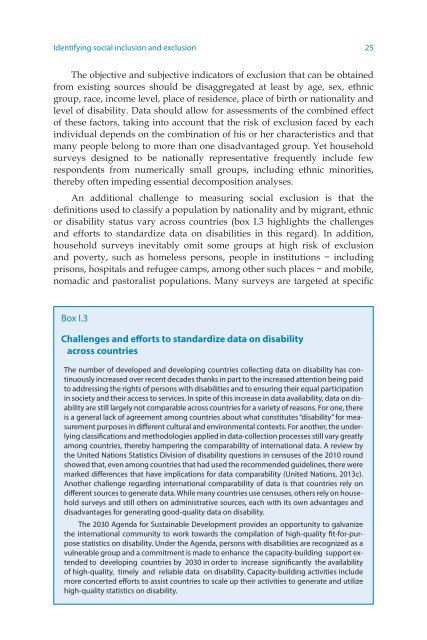Leaving no one behind the imperative of inclusive development
full-report
full-report
Create successful ePaper yourself
Turn your PDF publications into a flip-book with our unique Google optimized e-Paper software.
Identifying social inclusion and exclusion 25<br />
The objective and subjective indicators <strong>of</strong> exclusion that can be obtained<br />
from existing sources should be disaggregated at least by age, sex, ethnic<br />
group, race, income level, place <strong>of</strong> residence, place <strong>of</strong> birth or nationality and<br />
level <strong>of</strong> disability. Data should allow for assessments <strong>of</strong> <strong>the</strong> combined effect<br />
<strong>of</strong> <strong>the</strong>se factors, taking into account that <strong>the</strong> risk <strong>of</strong> exclusion faced by each<br />
individual depends on <strong>the</strong> combination <strong>of</strong> his or her characteristics and that<br />
many people belong to more than <strong>one</strong> disadvantaged group. Yet household<br />
surveys designed to be nationally representative frequently include few<br />
respondents from numerically small groups, including ethnic mi<strong>no</strong>rities,<br />
<strong>the</strong>reby <strong>of</strong>ten impeding essential decomposition analyses.<br />
An additional challenge to measuring social exclusion is that <strong>the</strong><br />
definitions used to classify a population by nationality and by migrant, ethnic<br />
or disability status vary across countries (box I.3 highlights <strong>the</strong> challenges<br />
and efforts to standardize data on disabilities in this regard). In addition,<br />
household surveys inevitably omit some groups at high risk <strong>of</strong> exclusion<br />
and poverty, such as homeless persons, people in institutions − including<br />
prisons, hospitals and refugee camps, among o<strong>the</strong>r such places − and mobile,<br />
<strong>no</strong>madic and pastoralist populations. Many surveys are targeted at specific<br />
Box I.3<br />
Challenges and efforts to standardize data on disability<br />
across countries<br />
The number <strong>of</strong> developed and developing countries collecting data on disability has continuously<br />
increased over recent decades thanks in part to <strong>the</strong> increased attention being paid<br />
to addressing <strong>the</strong> rights <strong>of</strong> persons with disabilities and to ensuring <strong>the</strong>ir equal participation<br />
in society and <strong>the</strong>ir access to services. In spite <strong>of</strong> this increase in data availability, data on disability<br />
are still largely <strong>no</strong>t comparable across countries for a variety <strong>of</strong> reasons. For <strong>one</strong>, <strong>the</strong>re<br />
is a general lack <strong>of</strong> agreement among countries about what constitutes “disability” for measurement<br />
purposes in different cultural and environmental contexts. For a<strong>no</strong><strong>the</strong>r, <strong>the</strong> underlying<br />
classifications and methodologies applied in data-collection processes still vary greatly<br />
among countries, <strong>the</strong>reby hampering <strong>the</strong> comparability <strong>of</strong> international data. A review by<br />
<strong>the</strong> United Nations Statistics Division <strong>of</strong> disability questions in censuses <strong>of</strong> <strong>the</strong> 2010 round<br />
showed that, even among countries that had used <strong>the</strong> recommended guidelines, <strong>the</strong>re were<br />
marked differences that have implications for data comparability (United Nations, 2013c).<br />
A<strong>no</strong><strong>the</strong>r challenge regarding international comparability <strong>of</strong> data is that countries rely on<br />
different sources to generate data. While many countries use censuses, o<strong>the</strong>rs rely on household<br />
surveys and still o<strong>the</strong>rs on administrative sources, each with its own advantages and<br />
disadvantages for generating good-quality data on disability.<br />
The 2030 Agenda for Sustainable Development provides an opportunity to galvanize<br />
<strong>the</strong> international community to work towards <strong>the</strong> compilation <strong>of</strong> high-quality fit-for-purpose<br />
statistics on disability. Under <strong>the</strong> Agenda, persons with disabilities are recognized as a<br />
vulnerable group and a commitment is made to enhance <strong>the</strong> capacity-building support extended<br />
to developing countries by 2030 in order to increase significantly <strong>the</strong> availability<br />
<strong>of</strong> high-quality, timely and reliable data on disability. Capacity-building activities include<br />
more concerted efforts to assist countries to scale up <strong>the</strong>ir activities to generate and utilize<br />
high-quality statistics on disability.
















